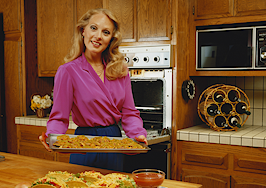In these times, double down — on your skills, on your knowledge, on you. Join us Aug. 8-10 at Inman Connect Las Vegas to lean into the shift and learn from the best. Get your ticket now for the best price.
The dawn of the new millennium brought many architectural design innovations, most importantly, the McMansion. This architectural style, which became a blemish on the suburban landscape, is an oversized house characterized by a pastiche of styles.
Tuscan style, a rustic Italian countryside aesthetic featuring terracotta tile floors, rough plaster walls, and exposed dark-stained wood beams, was first seen in the year 2000 and then everywhere for the next 10 years. Perhaps the most significant design innovation of 2000 was the widespread introduction of the internet. Now, homeowners could research design styles and sources online.
“Faux” and “textured” were the most commonly used words to describe architectural and interior design of the 2000s. Creating an ambiance of old money and history was the design goal of this time period.
Another housing style that was a spin-off of this newly built but old-appearing architecture was the Craftsman-style house. These houses were more humble and homey than McMansions but still hoped to achieve an old appearance through the use of gabled rooflines and exterior tapered columns.
Housing stock built in the 2000s was characterized by open floor plans and oversized kitchens. The most commonly found design style of both kitchens and baths was the Tuscan or Italian country style.
Kitchen styles of the 2000s
Most frequently found in traditional homes, the Tuscan kitchen had as its centerpiece the stove, often centrally located in an arched rustic brick alcove surrounded by rough plaster. A stovetop pot filler or hinged swing arm faucet that extended from the wall above the stove allowed pots to be filled with water without carrying them to the sink. Ostensibly, this pot filler was used to fill large stock pots with water for cooking pasta, and it became a status symbol of the 2000s.
Rustic beams and cabinets completed the Tuscan kitchen, along with terracotta floor tiles or travertine patterned floors.
Countertops were always dark granite with backsplashes of handmade Italian tile with a floral or rustic motif. Overhead, dark-stained weathered beams were added, whether structural or not. Oil-rubbed bronze hardware and faucet sets completed the country kitchen feel. Pendant lights with glass globes hung above the central island to complete the rustic look.
At the same time that traditional architecture featured Tuscan kitchens, more modern-style houses sported the all-white kitchen with black granite countertops. All appliances were stainless steel, lifted from commercial kitchens, and a new neutral in design. Both the rustic charm of the Tuscan kitchen and the coldness of the black and white kitchen with stainless steel appliances will look dated today when you show a house from this period.
Bathroom styles of the 2000s
Bathrooms also followed the kitchen design, with both Tuscan style and a more neutral, bland modern feeling in contemporary houses. Rustic wood columns surrounded raised bathtubs in Tuscan-style baths, with an abundance of brown and terracotta tile in traditional bathrooms.
Skylights were featured in bathrooms, as in kitchens, and pendant lights were seen in both. Rainfall showers, with water pouring from the ceiling above the shower rather than from the wall, were now seen everywhere. Spa showers with different water pressure settings and handheld shower ‘wands’ were coming into vogue.
McMansions were grand, with dramatic double-height features and sweeping staircases, sometimes double “Cinderella staircases.” Enormous chandeliers topped these dramatic spaces, a foretaste of the kitchens and bathrooms to follow inside these homes.
Houses of this scale were tributes to the financial success of their owners and were lavish in every sense of the word. In the 2000s, the home theater, with plush theater seating on graded or stepped levels, bars and refreshment zones featuring the ubiquitous popcorn machine, were status symbols to be achieved.
Real estate agents who understand the details of design and the technicalities of kitchens and baths of the 2000s will be better able to serve their clientele. The ability to discuss style, features and the changing lifestyle of homeowners from one decade to the next will prove to be very helpful in serving an agent’s clients.
Gerard Splendore is a licensed associate real estate broker with Warburg Realty in New York. Connect with him on LinkedIn.













